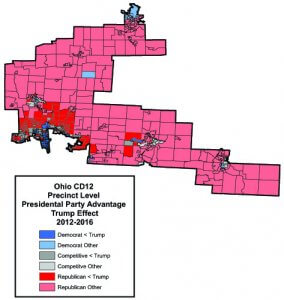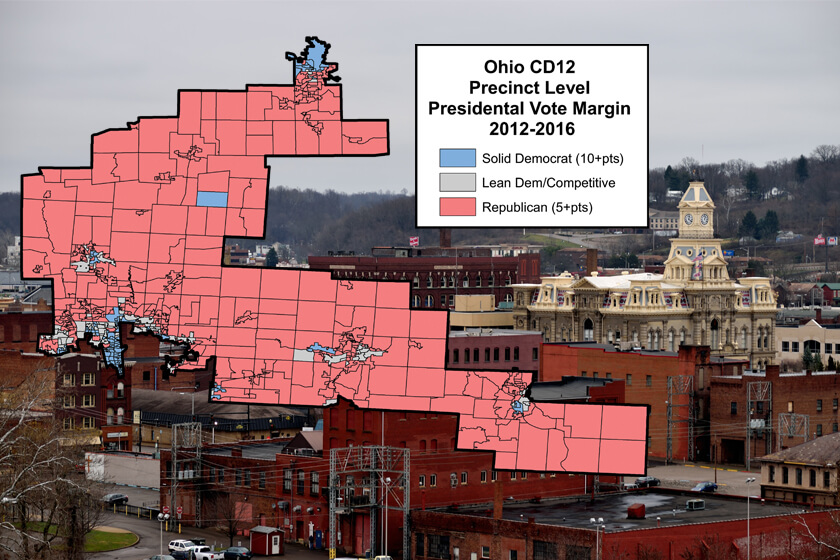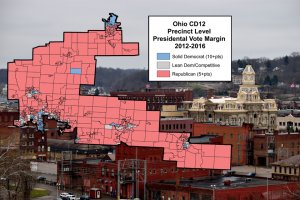West Long Branch, NJ – Republican State Senator Troy Balderson appears to have a slight advantage over Democratic county official Danny O’Connor in the special House of Representatives contest in Ohio’s 12th Congressional District. The election to fill the vacant seat will be held on August 7, but the Monmouth University Poll finds that few voters in either party show a lot of interest in the race.
Balderson holds a 43% to 33% lead over O’Connor among all potential voters – that is voters who have participated in an election since 2010 or have newly registered to vote (a group that represents about 87% of all registered voters in the district). Joe Manchik – the Green Party candidate who earned nearly 4% of the vote when he ran for the seat two years ago – earns just 1% and a relatively large 21% are undecided. Independents (33%) and Republicans (16%) are more likely than Democrats (8%) to say they are undecided.
The race does not look much different using two likely voter models. A historical midterm-like turnout model gives Balderson a 48% to 39% lead, while a model that includes a turnout surge in Democratic areas, mainly in Franklin County, narrows that edge slightly to 46% for Balderson and 39% for O’Connor. The margins in these models are at the edge of the range of uncertainty for the likely voter samples. This means that a slight O’Connor edge is still possible – especially given the large number of undecided voters – but it is significantly more likely that Balderson leads at this point in the race.
Former Ohio-12 incumbent Pat Tiberi, who resigned the seat earlier this year, won the seat by between 27 and 40 points in his last three re-election bids. While the polling margin for the open seat is much smaller than that range, it is in line with recent GOP presidential candidate performances – both Trump in 2016 and Mitt Romney in 2012 won the district by approximately 10 points.
“The fact that there isn’t a lot of difference between the pool of potential voters and the various likely voter models suggests that we aren’t seeing the level of Democratic enthusiasm that has made other special elections more competitive. Democrats seem to be more settled on a candidate than Republicans and O’Connor may have an opening to win over some of those undecided voters. But the real challenge may be motivation rather than persuasion,” said Patrick Murray, director of the independent Monmouth University Polling Institute.
Few Ohio-12 voters are paying attention to this race. Only 6% say they have been following the contest very closely and 35% have been following somewhat closely. Furthermore, just 38% say they have a lot of interest in the election. Working against the Democrat in this race is the lack of a partisan enthusiasm gap that has been seen in other special elections over the past year. Similar numbers of Republicans (40%) and Democrats (44%) say they have a lot of interest in this election. Similarly, 45% of Republicans and 45% of Democrats say they have been following the race at least somewhat closely.
“Balderson seems to be doing reasonably well with core GOP voting blocs, but O’Connor is not running up the score in areas where he needs to over-perform in order to pull off the upset,” said Murray.

O’Connor has a 43% to 33% lead in his home county of Franklin which comprises about a third of the Ohio-12 electorate, but Balderson leads in the rest of the district. White voters without a college degree back Balderson by a 50% to 23% margin whereas those who hold a college degree prefer O’Connor by a much narrower 43% to 39% margin. Black, Asian, and Latino voters back O’Connor by 55% to 25%, but this group makes up only 12% of the potential electorate.
Another sign that this particular election has not caught fire with voters is that neither major party candidate is particularly well known. Balderson gets a 31% favorable and 13% unfavorable rating with 55% having no opinion. O’Connor gets a similar 27% favorable and 11% unfavorable rating with 62% having no opinion. Both candidates are seen similarly as being either in touch (27% for Balderson and 25% for O’Connor) or out of touch (21% for Balderson and 19% for O’Connor) with district residents.
“This race appears to be flying under the radar for most voters. The national environment seems to be helping keep the Republican lead smaller than usual, but may not be increasing voter engagement all that much,” said Murray.
Ohio-12 voters are split in their opinion of Pres. Trump – 48% approve and 47% disapprove of his job performance. However, slightly more voters (48%) support what Trump is doing on most issues than are opposed (41%). Just over half of voters (53%) say it is very important that they cast a vote for Congress that shows how they feel about the president. Those who oppose Trump (64%) are somewhat more likely than Trump supporters (56%) to feel this way, but since they are outnumbered by supporters this does not necessarily translate into an electoral advantage for the House Democratic candidate.
Voters do not hold overwhelmingly positive views of the two major parties – 44% favorable and 43% unfavorable for the Republican Party, which is slightly better than 36% favorable and 47% unfavorable for the Democratic Party. They also express a slight preference for having the GOP (43%) rather than the Democrats (34%) in control of Congress.
The Monmouth University Poll was conducted by telephone from June 7 to June 10, 2018 with 501 Ohio voters in Ohio’s 12th Congressional District August special election. The question results in this release have a margin of error of +/- 4.4 percentage points for the full sample and +/- 5.1 percentage points for the likely voter models. The error of the gap between the two candidates’ vote share (i.e. the margin of the “lead”) is +/- 6.0 percentage points for the full sample and +/- 7.1 percentage points for the likely voter models. The poll was conducted by the Monmouth University Polling Institute in West Long Branch, NJ.
QUESTIONS AND RESULTS
(* Some columns may not add to 100% due to rounding.)
1/2. If the election for U.S. House of Representatives in your district was today, would you vote for Troy Balderson the Republican, Danny O’Connor the Democrat, Joe Manchik of the Green Party, or some other candidate? [IF UNDECIDED: If you had to vote for one of the following at this moment, do you lean more toward Troy Balderson or more toward Danny O’Connor?] [NAMES WERE ROTATED]
| With leaners |
June 2018 | ||
|
Likely Voter Models | |||
|
Full voter |
Standard |
Democratic | |
| Troy Balderson | 43% | 48% | 46% |
| Danny O’Connor | 33% | 39% | 39% |
| Joe Manchik | 1% |
<1% |
<1% |
| Other | 2% | 1% | 1% |
| (VOL) Undecided | 21% | 12% | 13% |
| (n) | (501) | (371) | (371) |
[QUESTIONS 3 & 4 WERE ROTATED]
3. Is your general impression of Troy Balderson very favorable, somewhat favorable, somewhat unfavorable, or very unfavorable, or do you have no opinion of him?
| June 2018 | |
| Very favorable | 10% |
| Somewhat favorable | 21% |
| Somewhat unfavorable | 4% |
| Very unfavorable | 9% |
| No opinion | 55% |
| (n) | (501) |
4. Is your general impression of Danny O’Connor very favorable, somewhat favorable, somewhat unfavorable, or very unfavorable, or do you have no opinion of him?
| June 2018 | |
| Very favorable | 10% |
| Somewhat favorable | 17% |
| Somewhat unfavorable | 6% |
| Very unfavorable | 5% |
| No opinion | 62% |
| (n) | (501) |
5. How much interest do you have in the upcoming special election for House of Representatives – a lot of interest, a little interest, or not much interest at all?
| June 2018 | |
| A lot | 38% |
| A little | 37% |
| Not much at all | 24% |
| (VOL) Don’t know | 0% |
| (n) | (501) |
6. Have you been following the campaign in your Congressional district very closely, somewhat closely, or not too closely?
| June 2018 | |
| Very closely | 6% |
| Somewhat closely | 35% |
| Not too closely | 59% |
| (n) | (501) |
7. Do you approve or disapprove of the job Donald Trump is doing as president? [Do you (approve/disapprove) strongly or somewhat?]
| June 2018 | |
| Strongly approve | 34% |
| Somewhat approve | 14% |
| Somewhat disapprove | 9% |
| Strongly disapprove | 38% |
| (VOL) Don’t know | 5% |
| (n) | (501) |
8. On most issues would you say you support or oppose what President Trump is doing?
| June 2018 | |
| Support | 48% |
| Oppose | 41% |
| (VOL) Depends/both | 7% |
| (VOL) Don’t know | 4% |
| (n) | (501) |
9. How important is it for you to cast a vote for Congress that shows your [support of/opposition to] President Trump – very important, somewhat important, not too important, or not at all important?
| June 2018 | |
| Very important | 53% |
| Somewhat important | 23% |
| Not too important | 5% |
| Not at all important | 5% |
| (VOL) Don’t know | 13% |
| (n) | (501) |
[QUESTIONS 10 & 11 WERE ROTATED]
10. Is your general impression of the Republican Party very favorable, somewhat favorable, somewhat unfavorable, or very unfavorable, or do you have no opinion?
| June 2018 | |
| Very favorable | 12% |
| Somewhat favorable | 32% |
| Somewhat unfavorable | 18% |
| Very unfavorable | 25% |
| No opinion | 13% |
| (n) | (501) |
11. Is your general impression of the Democratic Party very favorable, somewhat favorable, somewhat unfavorable, or very unfavorable, or do you have no opinion?
| June 2018 | |
| Very favorable | 8% |
| Somewhat favorable | 28% |
| Somewhat unfavorable | 18% |
| Very unfavorable | 29% |
| No opinion | 16% |
| (n) | (501) |
12. Would you rather see the Republicans or the Democrats in control of Congress, or doesn’t this matter to you?
| June 2018 | |
| Republicans | 43% |
| Democrats | 34% |
| Does not matter | 19% |
| (VOL) Don’t know | 4% |
| (n) | (501) |
[QUESTIONS 13 & 14 WERE ROTATED]
13. Do you think Troy Balderson is in touch or out of touch with the residents of this district?
| June 2018 | |
| In touch | 27% |
| Out of touch | 21% |
| (VOL) Don’t know | 52% |
| (n) | (501) |
14. Do you think Danny O’Connor is in touch or out of touch with the residents of this district?
| June 2018 | |
| In touch | 25% |
| Out of touch | 19% |
| (VOL) Don’t know | 56% |
| (n) | (501) |
METHODOLOGY
The Monmouth University Poll was sponsored and conducted by the Monmouth University Polling Institute from June 7 to June 10, 2018 with a random sample of 501 potential voters in Ohio’s 12th Congressional District, drawn from a list of registered voters who voted in at least one of the last four general elections or have registered to vote since January 2016. This includes 250 contacted by a live interviewer on a landline telephone and 251 contacted by a live interviewer on a cell phone. Monmouth is responsible for all aspects of the survey design, data weighting and analysis. Final sample is weighted for region, party registration, age, gender, education and race based on state voter registration list and U.S. Census information. Data collection support provided by Braun Research (field) and L2 (voter sample). For results based on this sample, one can say with 95% confidence that the error attributable to sampling has a maximum margin of plus or minus 4.4 percentage points (unadjusted for sample design). Sampling error can be larger for sub-groups (see table below). In addition to sampling error, one should bear in mind that question wording and practical difficulties in conducting surveys can introduce error or bias into the findings of opinion polls.
| DEMOGRAPHICS (weighted) |
| Party Primary History |
| 40% Republican |
| 28% Democrat |
| 31% Neither |
| Self-Reported Party ID |
| 39% Republican |
| 36% Independent |
| 24% Democrat |
| 50% Male |
| 50% Female |
| 14% 18-34 |
| 25% 35-49 |
| 31% 50-64 |
| 30% 65+ |
| 88% White, non-Hispanic |
| 12% Other |
| 58% No college degree |
| 42% 4-year college degree |
| 27% Delaware County |
| 32% Franklin County |
| 22% Licking County |
| 19% Other counties |
Click on pdf file link below for full methodology and results by key demographic groups.




